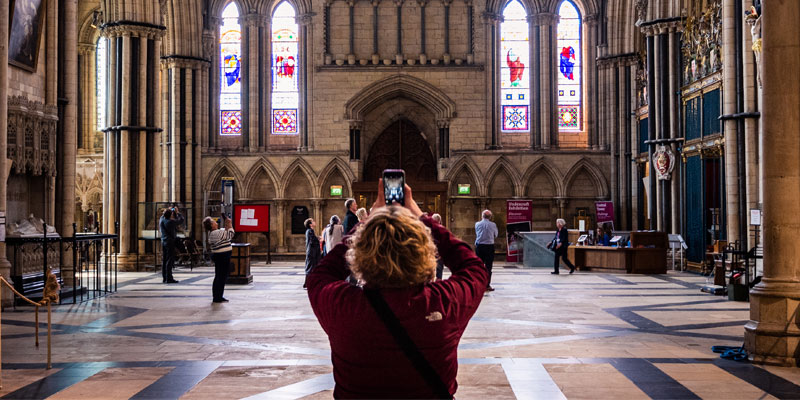Changing policy and public engagement for England’s largest heritage sector
-
Case study
- Culture and Communication
Our research has changed national and institutional policy for heritage management and enhanced public engagement with English cathedrals and other sacred sites.

For pilgrims in the Middle Ages, cathedrals and churches provided a very rich sensory experience with lots of things for them to see, do, smell and touch. We need to ask what we are offering visitors today and how they can engage with the stories which have shaped these great buildings.
The issue
The Church of England (CofE) has over 12,500 listed church buildings. Many of their most magnificent, complex and ancient buildings are cathedrals, which receive over nine million visitors annually.
Churches make up the largest proportion of England’s built heritage. But securing their economic and social importance requires continually engaging new audiences. Key policymakers have recognised this as a strategic priority.
The research
Our research examined four historical and contemporary sacred sites; Canterbury, York, Durham and Westminster. This sample represents a range of historical, social, geographical and denominational settings with varying policies on charging for entry.
Using an innovative combination of methodologies drawn from history, theology, religious studies and social anthropology we examined engagement with sacred places from the 11th to the 21st centuries, including pilgrimages. We assessed the growing significance of England’s cathedrals as sacred, heritage and tourist sites. From this information we were able to suggest timely strategies to enhance visitor engagement.
Going inside the churches, we conducted an analysis of architectural and visual material, archives and contemporary documents. Through questionnaires, interviews and participant observation we were able to analyse the experiences and views of cathedral staff, volunteers, visitors and local residents, of all faiths or none. We then used digital modelling to interrogate spatial relationships and test hypotheses about medieval pilgrim's interaction with buildings.
The outcome
Through engaging with key policymakers at every level, from the governing and statutory advisory bodies of the CofE to those of a broad spectrum of individual cathedrals, our research is acknowledged as having changed the regulatory landscape, with national organisations creating changes in policy, guidance and decision-making across the sector.
On a more local level, as a direct result of engaging with our research individual cathedrals have:
- better understood the history, architectural design and experiential dynamics of their buildings
- opened up spaces and improved signage to encourage exploration
- retrained volunteers to treat all visitors positively and openly
- increased provision of sensory experience and interaction
- changed worship patterns, making services more visible, audible and accessible
- created new interpretation approaches to enhance visitor engagement and enjoyment.
Our research has transformed the 21st-century visitor experience by enhancing institutional and public understanding of the history of England’s cathedrals. We facilitated engagement with sacred sites, promoting tourism through innovative recreation and presentation of shared national and local cultural heritage, resulting in the promotion of learning, wellbeing and community identity.

Dee Dyas
Research Title: Director of the Centre for the Study of Christianity and Culture
Dr Dyas' research interests and publications have focused primarily on the history, experience and significance of pilgrimage from the earliest centuries to the present day and the interaction of Christian belief and practice with Western culture, especially literature and art.
